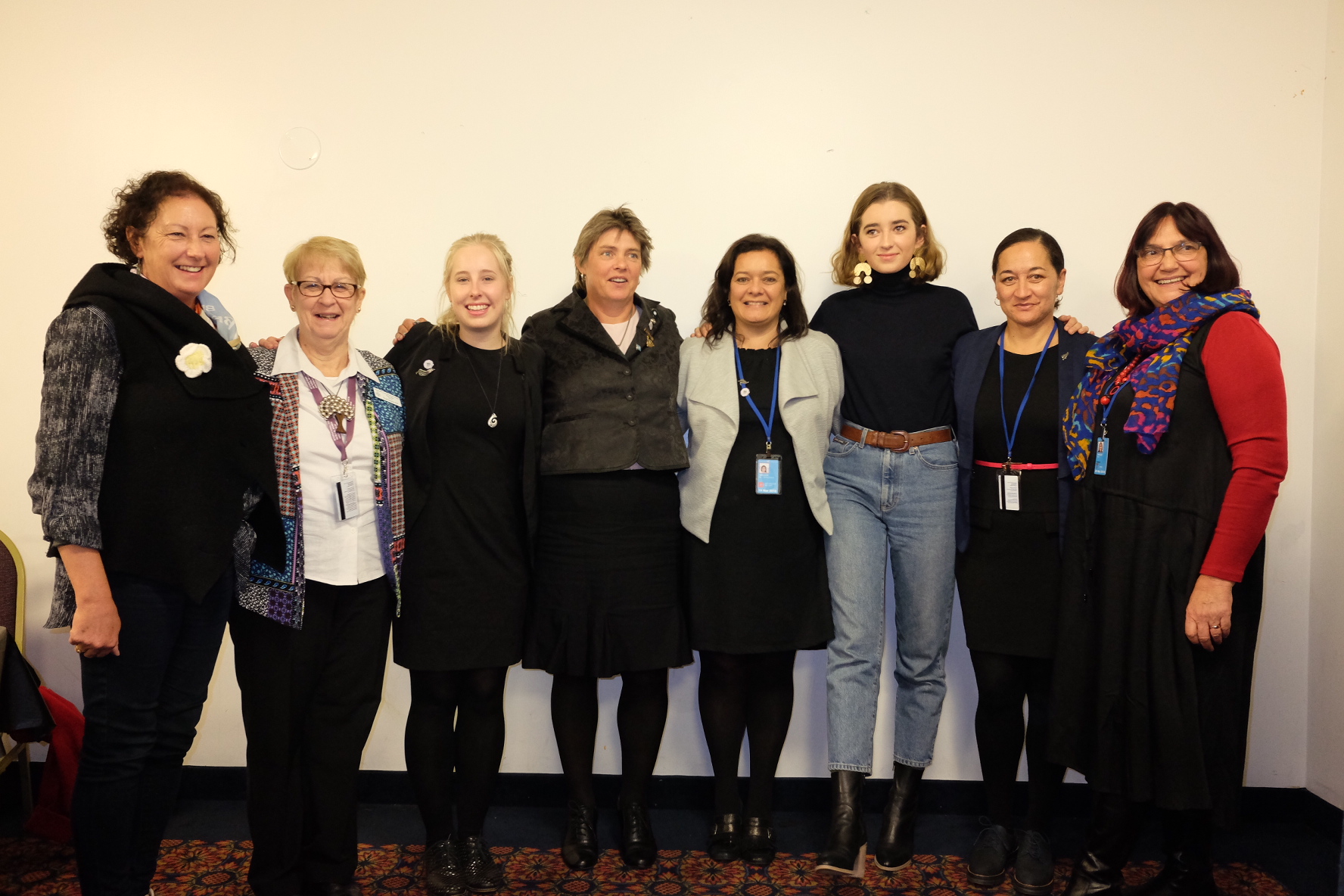In the midst of the intense learning (and listening) curve that is CSW62, I was honoured to speak on a panel in the side event schedule about the digital empowerment of women and girls from rural areas in Aotearoa. Below was the speech I delivered, if any of our AYLI blog readers are interested.
Lauren with fellow speakers on the panel. From left to right: Janet Gibb, Ruth Shanks, Ashleigh Smith, Fiona Gower (Rural Women New Zealand), Renee Graham (Ministry for Women), Lauren, Helen Potiki (Ministry for Women), Hellen Swales (Moderator). Photo credit: Lucretia Dobrec
Thank you for your introduction Hellen, and thank you to Rural Women New Zealand and the New Zealand Human Rights Commission for asking me to this panel.
I want to speak to the enormous opportunity we have with media and how we can use it as a tool of empowerment for rural women. It can help to increase entrepreneurship in our rural communities, and also mobilise large groups of women across communities regardless of isolation, around rights-based issues. Before these opportunities can be realised, however, we need to highlight the existing digital inequality our women and girls are facing in rural areas, and the need for equitable connectivity across New Zealand.
We are seeing this lack of digital empowerment in our young rural girls already. In New Zealand, children in rural areas are facing increased digital illiteracy compared to children in urban areas, due to a lack of equal connectivity. This is obviously a concern when rural girls are only receiving adequate access to digital resources when they reach high school, putting them behind children from urban areas.
Our national correspondence school, Te Kura has transitioned to internet learning, and have stopped supplying their rural students with paper learning materials. There is an estimated seven-year lag on the installation of broadband in our rural areas.
This places our young rural women and girls at a disadvantage for future work environments. In the twenty-first century, in a world where more people have an internet connection than have clean running water, in a world that is fast transitioning to careers that depend on digital competency and the use of technology systems, this is a significant inequality. New Zealand rural women are at a clear digital disadvantage when it comes to working, and therefore earning power.
We must come up with solutions for women in rural areas who want to remain in their communities, but also want to run their own businesses in the future. Fiona spoke about the New Zealand Rural Women Enterprising Rural Women Awards, and case studies of women who operate businesses in their communities. This is progress for these women, who often operate their businesses on their own terms while also performing large amounts of unpaid labour in childcare, working on their family farms, and holding leadership positions in their communities on committees and organisations. But going forward into an unavoidable digital-based future, they will lack outreach in terms of marketing and promoting their work outside of their rural communities. It is important to also bring young rural women into this space, as they are our future businesswomen and backbones of their own rural communities.
In preparation for this panel I circulated a survey to as many rural women as I could reach, asking about the challenges and advantages of living in their rural areas. Many of them named the dual challenges of digital connectivity and isolation. The biggest advantage, specified by the most women was a quality of life they can’t get in urban areas.
In terms of rural women and girls and entrepreneurship, I see a key question being how can we improve marketing opportunities outside of rural communities, so that women can continue running their small businesses while still living the rural lifestyle they value. Fiona spoke of examples like Shear Warmth, and Hammond & Davidson Accountants. On the whole, women are happy living in their rural communities, with the advantages of employment autonomy, independence, strong community and peaceful environment this lifestyle provides. Our rural women would have more opportunities to bring their businesses to the rest of the country, while having the resources to stay within their communities if they had equitable access to digital connectivity.
In the short term, we need investment in centres where women can access the internet and effect these changes in their communities. Rural schools may work to service this need, as children often have better access to the internet at school than they do at home. In the long term, we need urgent action from telecommunications companies to roll out this nationwide internet installation. It is fundamentally unfair to rural women to have to choose between their quality of rural life and their accessibility to an increased income and empowerment as a result of digital equality.
I work at Double Denim, an strategic female communications agency which has completed extensive research on the consumer behaviour of women and the potential of the female economy in Aotearoa. We asked New Zealand women questions that no other statistics or data research company is bothering to find out. We needed the data in order to hold our system accountable. Rural women make up a significant demographic of our population, but the government hasn’t even measured the exact numbers. We are going to lose out economically if we don’t improve digital connectivity for this segment so that rural women and girls can work the way they want to. In our study we found that women reinvest up to 90% of their income in their families and communities. They spend the most earned income on food, healthcare, home improvement and schooling for themselves and their children. Women are not a blip or a niche. We are a powerful group with the opportunity to craft our own narratives, choose how we are represented, and set our own agendas and futures.
The lesson is to use digital technology to create safe spaces for women to raise their consciousness, share experiences and to encourage real world action. One of the biggest influences on me growing up in a rural area is the importance of community. My mother was in my primary school parent teacher association, she coached multiple sports teams, was on my kindergarten’s committee, and she is on my old high school’s board of trustees. Community is a part of life in a rural area. Our social life and support came from our community. And now, ten or twenty years later, we have the ability to also build communities online.
As I found from my survey, isolation is a serious issue for women and girls in rural areas. This can have significant effects on mental health. Women and girls may feel these effects from moving to a rural area from an urban area or through geographical distance from their neighbours and friends. Social media communities can work to bridge some of this isolation by offering solidarity, a sense of friendship and connection. Facebook groups for Farming Mothers, Women in Farming and Young Farmers Clubs are all popular digital communities with large followings that women and girls in rural areas are using to connect to one another.
Fiona spoke about the difficulties of getting rural women’s issues into mainstream media. With digital equality, social media can be used by rural women to tell their stories in the ways they want to tell them, and to amplify women’s rights issues. In 2017 I worked on a campaign called Treat Her Right, with the New Zealand Council of Trade Unions. Aimed at increasing awareness of New Zealand’s gender pay gap, it created a national conversation and education, in an effort to get this issue on the agenda of political parties ahead of the 2017 election. The campaign video was viewed over one hundred thousand times and the website housed information on the long history of New Zealand’s equal pay movement, and also called for the recognition of the value of unpaid labour, like the work done by rural women every day in their communities. By leveraging digital marketing practises for a women’s rights issue, and anchoring the campaign online through video and a dedicated website, our outreach was huge. We amassed a broad national audience of women and increased the exposure of our key messaging. Results from this campaign and progress on the issue of the gender pay gap came when Prime Minister Jacinda Ardern publicly committed to pay equity in Labour’s policies in 2017.
I read a really relevant quote from British feminist writer Caitlin Moran when preparing a conference talk last year, and I would like to finish with it now. “Previously it was the men down in the pubs talking about politics and society. Now, with the internet women can be at home communicating, mobilising and changing the world.” The correlation is clear: we can empower women and girls in rural areas if we prioritise achieving digital equality.
Follow Lauren’s email newsletter here, and follow her on Twitter here.
--
All posts by Institute delegates reflect their own thoughts, opinions and experiences.

